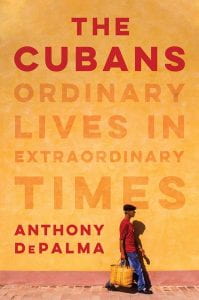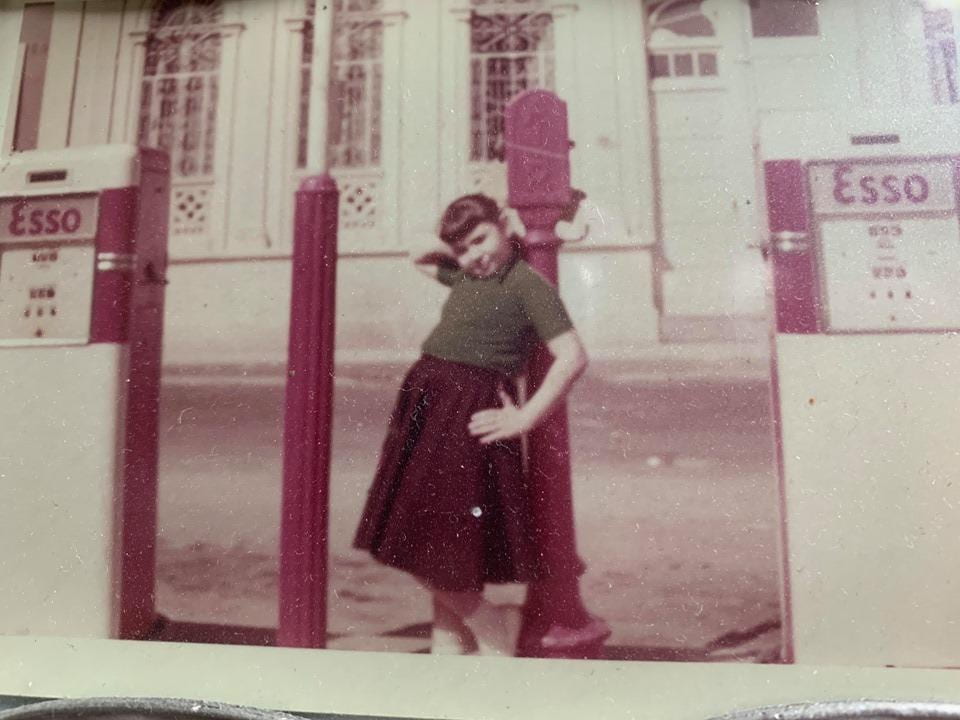A Review of The Cubans
Close and Personal: An Unvarnished Look at Revolutionary Cuba
Reading the new book The Cubans: Ordinary Lives in Extraordinary Times made me nostalgic for my years on the island as a U.S. news correspondent. I certainly didn’t miss the struggles or hassles, of which there were plenty, but it made me long for the intelligent, engaging, and yes, sometimes infuriating Cuban people I met along the way, worked with, fought with, laughed with, and many times befriended.
Former foreign correspondent Anthony DePalma’s exhaustively reported book is an unvarnished look at revolutionary Cuba seen through the eyes of those islanders, some of who easily could have been his Cuban wife’s neighbors if her family hadn’t fled the country after Fidel Castro came to power in 1959.
In his author’s note, DePalma describes a Kodachrome that seems to be at least partial inspiration for his project. The faded photograph shows his wife, Miriam, as a little girl posing like a movie star between a pair of red and white Esso gas tanks in Guanabacoa (wan-a-ba-COH-ah), the historic municipality where she spent her early years across the bay from Havana. Beginning his research in that centuries-old community, Guanabacoa also becomes the setting for the interconnected life stories in DePalma’s book. Braided together, they form a kind of love letter not only to Miriam but to the hundreds of thousands of ordinary Cubans who remained on the island, by circumstance or choice.
The Cubans introduces us to people living amid the collapsing buildings and trash heaps of gritty Guanabacoa through the monumental changes of recent history as the Soviet Union collapsed, the island economy was plunged into economic crisis, and the communist leadership began allowing a small amount of capitalism to exist under tightly controlled conditions. The Cubans endure shortages and other hardships in a country where it can be as hard to find a place to bury your dead as it is to find a place to live. Over time, the loyalists among them start questioning whether they are faithful to the revolution or their homeland. History is changing the revolution as they recount their stories, marked by Fidel Castro’s 2016 death and Raúl’s carefully planned departure from power two years later.
DePalma visited Cuba numerous times during his 22 years as a foreign correspondent for the New York Times, focusing on Latin America, and is the author of The Man Who Invented Fidel about the New York Times reporter Herbert L. Matthews and Here: A Biography of the New American Continent.
Unlike many books about the island, The Cubans doesn’t dwell much on Fidel and Raúl Castro, and breezes right past the ideology of the left and right. Instead, it is about resilient and resourceful individuals who seem to innately know from birth how to “resolver”—creatively resolve their predicaments—to survive. The individuals DePalma writes about are not ordinary at all, but complex, three-dimensional people, drawn with a nuanced and empathetic hand.
Like DePalma, I was constantly surprised during my time on the island by the ingenuity of the Cubans I met, from people who fed their family for years with food stolen from the stores or factories where they worked to a family that built a raft with a vintage Chevy truck they “drove” almost all the way to Key West in 2003 before the U.S. Coast Guard picked them up and took them back home. I was also taken with Cubans’ irony and wicked humor amid restrictions and scare supplies of goods.
In his book, De Palma introduces us to internationally renowned artist Arturo Montoto, who returns to his native Cuba after a decade living in Mexico. But he’s frustrated with the lack of paints, canvases and other materials he needs to work and refers sardonically to his favorite rum and cola cocktail, the Havana Libre, or Free Havana, as the Ha-Ha-Ha.
Living in the same house her family has owned for more than a century, fellow Guanabacoa resident Maria del Carmen “Mari” Lopez Alvarez finds solace at the nearby Los Escolapios church and in her passion for Spanish dance. Maria Luisa “Lili” Durand Hernandez, a fervent revolutionary, struggles unsuccessfully to join the Communist Party as her son is focused on leaving the island.
Jorge A. García had also lived in the historic municipality of Guanabacoa his entire life before losing several members of his family in the July 1994 sinking of the 13 de Marzo tugboat off the island’s coast. Fourteen of the 37 people on the old vessel who drowned in a confrontation with the Cuban Coast Guard were his relatives.
It was later alleged that the Coast Guard deliberately sank the vessel commandeered by people trying to get to the United States, but the Cuban government denied responsibility for what it says was an accident.
A veteran of the ten-million-ton sugar harvest of 1970 and the Angolan wars, García was sidelined by the state, even expelled from the local rescue squad, as he tracked down the stories of everyone who was on the boat in a quest to find the truth. The U.S. government ultimately helped García and his wife leave the island as refugees and they settled in South Florida, where he published a book about the tugboat tragedy. DePalma etches a sympathetic portrait of García as he tries to make his way in the United States, scraping a life together for himself and his wife, Elisa, recording voiceovers for Spanish-language radio even as the tragic deaths of their loved ones at sea continued to haunt them. Ultimately Elisa’s heart, damaged by so much sadness over the years, stopped beating. As the funeral expenses pushed García farther into debt , he threw up his hands and declared bankruptcy.
Another of the intriguing characters in DePalma’s book is Caridad Luisa “Cary” Limonata, a former ranking member of the Communist Party and ex-government vice minister who went on to become a successful entrepreneur with her own company as she made the transition from revolutionary to patriot.
We get to know Cary as a university student in Kiev, then later as manager of a government firm that printed thousands of T-shirts for the wave of government rallies held regularly during the first half of 2000 as Fidel Castro demanded that a 6-year-old castaway named Elián González be taken from his Miami relatives and returned to his father in Cuba. Elián’s mother was among those who died when their U.S.-bound boat sank off the coast of Florida. Elián survived only because he was lashed to an inner tube.
Raised in a sugar mill community, Cary fights to be taken seriously as a young black woman as she climbs up the government ladder. When the state later opens the possibility for some Cubans to own private businesses, Cary takes the jump and is among the entrepreneurs who met with President Barack Obama when he visited in 2016 to push for normalization.
Watching the meeting between Obama and Raúl Castro on television, I couldn’t help but think about what rapprochement might mean for the ordinary Cubans I crossed paths with during my own years on the island, Don Alberto, the elderly black man who was born the same year as Fidel Castro; Lucia, the woman who sold tomatoes at the market near my apartment; Enrique, the entrepreneur who operated a private restaurant.
Diplomatic relations improved under the leadership of Obama and Raúl Castro, but many of the gains have since eroded under the current administration of President Donald Trump.
Cuba’s future now seems as uncertain as ever with the Castro family out of power and a U.S. presidential election in November.
But whatever happens, DePalma has said he’ll always owe a debt to Fidel Castro. If not for the revolutionary leader, events would never have led DePalma to meet the green-eyed girl in that photograph taken so long ago.
Spring/Summer 2020, Volume XIX, Number 3
Anita Snow reopened The Associated Press’ Havana office in 1999 after a nearly 30-year absence and went on to serve as the news agency’s Cuba bureau chief for a decade. She has been based in Mexico City and the United Nations and now covers stories of national interest from the U.S. Southwest. She was a Harvard Nieman Fellow in 2010.
Related Articles
A Review of A Promising Past: Remodeling Fictions in Parque Central, Caracas
A beacon of modern urban transformation and a laboratory of social reproduction, Parque Central in Caracas is a monumental enclave of 20th-century Venezuelan oil-fueled progress. The monumental urban structure also symbolizes the enduring architectural struggle against entropy, acute in a country where the state routinely neglects its role in providing sustained infrastructural maintenance and social care. Like other ambitious modernizing projects of the Venezuelan petrostate, Parque Central’s modernity was doomed due to the state’s dependence on the global oil economy’s cycles of boom and bust.
A Review of Bodies Found in Various Places
This bilingual anthology of Elvira Hernández, translated by Daniel Borzutzky and Alec Schumacher and published by Cardboard House Press, offers a comprehensive entry point into the work of the Chilean poet. The translators’ preface offers a valuable introduction that provides important context to her work and explains aspects of her poetry present in the volume, such as Hernández’s self-effacing “ethics of invisibility,” an ars poetica in which the poems stand in front while the poet hangs back, in a call to observe rather than to be observed. In this sense, Hernández has long written from the edges of Chile’s public life, partly by choice, partly by necessity: her birth name is Rosa María Teresa Adriasola Olave, but she adopted the pseudonym of Elvira Hernández under the Pinochet dictatorship.
A Review of An Ordinary Landscape of Violence
When first reading the title, An Ordinary Landscape of Violence, I asked myself if there is really anything “ordinary” about a landscape of violence? Preity R. Kumar argues that violence is endemic to Guyana’s colonial history and is something that women loving women (WLW) contend with and resist in their personal and public lives.






